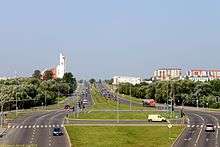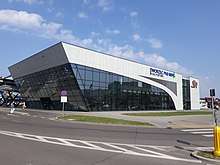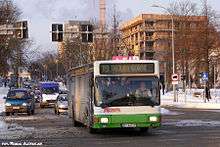Transport in Białystok
Białystok is, and has been for centuries, the main hub of transportation for the Podlaskie Voivodeship and the entire northeastern section of Poland. It is a major city on the European Union roadways (Via Baltica) and railways (Rail Baltica) to the Baltic Republics and Finland. It is also a main gateway of trade with Belarus due to its proximity to the border and its current and longstanding relationship with Hrodno, [Belarus. Passenger trains do connect from Suwałki, Hrodno and Lithuania to Warsaw and the rest of the European passenger network. An extensive public transportation system is provided within the city by three bus services, but no tram or subway exists.
A civil airport, Białystok-Krywlany Airport, lies within the city limits, but does not provide regularly scheduled service. There are plans to build a new regional airport, Białystok-Saniki Airport, in the next few years that will provide flights within Europe.
History

Before World War II Białystok had a horse tram network. After the war, plans for the electrification of the lines proved too costly and the lines were pulled down. Since then buses have been the only means of public transportation. There are plans to develop a rapid city rail system in the near future, using the existing railways within the city limits, which will improve the reliability of public transport.
Roads and highways
The National Roads (Polish: Droga krajowa) running through Białystok:








In Białystok there are also Poviat roads which connect the city with other towns in the area[1][2]:
- Poviat road 1431 B: Białystok (42 Pułku Piechoty Street) - Sowlany
- Poviat road 1432 B: Białystok (Ciołkowskiego and Baranowicka streets) - Zielona,
- Poviat road 1483 B: Białystok (Filipowicza) - Hryniewicze
- Poviat road 1484 B: Białystok (Mickiewicza Street) - Stanisławowo
- Poviat road 1485 B: Białystok (Plażowa Street) - Dojlidy Górne
- Poviat road 1493 B: Białystok (Wiosenna Street) - Olmonty
- Poviat road 1535 B: Białystok (Popiełuszki, Hetmańska and Wierzbowa Streets) - Choroszcz
- Poviat road 1550 B: Białystok (Niewodnicka, Meksińska, Nowosielska and Elewatorska streets) - Klepacze - Niewodnica Kościelna,
- Poviat road 1559 B: Białystok - Kleosin
Public transport
Bialystok is the largest city in Poland that has only one form of public transit (bus). There is an extensive bus network that covers the entire city. Tickets have to bought in advance - they are sold in many places, including newsagents, convenience stores, supermarkets and designated ticket retail points. Only in the latter can you buy daily and monthly bus passes. There are 29 city lines, 12 metropolitan lines and 6 night lines (weekends only) served by 3 bus operators partially owned by the municipality - KPKM, KPK and KZK. Each share approximately a third of the lines and the bus fleet.
History
One of the first means of urban transport were demobilized trucks owned by Miejski Zakład Komunikacyjny (MZK) in Białystok, which existed after Second World War and the establishment of the People's Republic of Poland. In 1954, this company was transformed into a Municipal Transport Company, MPK Bialystok, maintaining vehicles from Chausson, Star, Mavag, San, Autosan, ZIS and Jelcz in operation, and in the 1980s Ikarus was also the first articulated bus with the nidel 280.
A strike began on May 13, 1991. Employees demanded the resignation of the director, salary increases and discussions on the ownership transformations of the company. The legal patron Jerzy Korsak (then owner of the only private law office in Białystok, now a member of the Supreme Laywer's Council) came to the strikers and convinced them that in order to dismiss the director, the company had to be dissolved[3].
In February 2004, the functions of the Municipal Service Department were taken over by the Road and Transport Authority (ZDiT), and in June 2006 the Department of Urban Transport (WTM). In March 2007, the Urban Transport Department was merged with the Municipal Roads Department, resulting in the Department of Roads and Transport (DDT). Since the beginning of 2007, the name Białostocka Miejska has been used in relation to public transport in Białystok. Since 2010, the role of organizer of public transport has been the Authority of Bialystok Municipal Transport (BKM) (Polish: Zarząd Białostockiej Komunikacji Miejskiej).
On early 2016 there were calls from the city council to unite the 3 bus operators as it is costly for the city to own 3 different companies more or less with the same size who perform the same tasks. The mayor replied that this model works well and no further action was taken[4].
Rail transport
The main railway station is Białystok railway station and passenger services are provided by two rail service providers:
- PKP Intercity - intercity passengers trains (express, intercity, eurocity, hotel and TLK)
- Przewozy Regionalne - runs only regional passenger trains financed by the voivodeship. Passenger trains are mostly run using electrical multiple units (on electrified lines) or rail buses.[5]
Przewozy Regionalne provides service on the following routes:
- Białystok - Sokółka - Augustów - Suwałki
- Białystok - Sokółka - Kuźnica Białystok- Hrodno, Belarus
- Białystok - Warsaw
- Białystok - Mońki - Grajewo - Ełk
- Hajnówka - Czeremcha - Siemiatycze - Siedlce
- Białystok - Bielsk Podlaski - Czeremcha (Connects to Hajnówka - Siedlce service)
There are 13 trains a day from Warsaw, the first one leaving at 4.55 and the last one at 21.30. The journey takes about 2 hours and 30 minutes. 11 of those trains are operated by PKP Intercity and cost 39 zl (10 euro) for the second class and 59 zl (15 euro) for the first-class ticket. There are two second-class only trains operated by Przewozy Regionalne (PR) which cost 29 zl (7 euro). These leave Warsaw at 11.40 and 20.05. Białystok has also direct connections with other cities in northern Poland such as Gdańsk and Olsztyn.
For timetables and prices, see Polish State Railways.[6]
Intercity bus

PKS Nova operates coaches to most major cities in Poland. Although the coach journey takes much longer than the train and the price is usually more expensive, sometimes the timetables may be more convenient.
Air transport
Currently, the nearest airport to Białystok is a regional airport, Hrodna Airport in Hrodna, Belarus. Hrodna only provides domestic service within Belarus. The closest international airport to Białystok is Warsaw Frederic Chopin Airport in Warsaw.
Białystok-Krywlany Airport lies within city limits. It is currently used only by Aeroklub Białostocki,[7] a sports and recreational flying association, and by private airplanes.
Construction of a new regional airport, Białystok-Saniki Airport[8] 27 km west-northwest of Białystok in the village of Saniki, Gmina Tykocin, is set to begin in 2012 and completed in 2015.[9] In the first year of operation (2015), according to estimates of the Podlaskie Voidvodeship Marshal's Office, the airport will handle 12,000 passengers growing in 2020 to 145,000 passengers. The airport is proposed to have a runway length of 2,000 m and width of 60 m (45 m + band). It is projected to operate aircraft with a wingspan of up to 52 meters.[10] Construction of the airport is projected to cost five hundred million zł paid for by a combination of funding from the Podlaskie Voivodeship, the Polish Government and EU infrastructure funding.[11]
See also
References
- Patrycja Piórkowska. Komunikacja miejska jako element systemu transportowego miasta Białystok – wyniki badań, p. 106
- Drogi powiatowe
- "Samorządność na przekór wszystkim". ogólnopolski związek zawodowy inicjatywa pracownicza. 2008-02-09. Retrieved 2019-03-15.
- "Czy dojdzie do połączenia spółek komunikacyjnych w Białymstoku?". Polskie Radio. 2016-03-21. Retrieved 2019-03-15.
- "Przewozy Regionalne". Retrieved 23 January 2010.
- Archived 2011-07-18 at the Wayback Machine
- "Aeroklub Białostocki". Retrieved 2011-01-29.
- "Białystok-Saniki Airport". Retrieved 2011-01-29.
- "Poland to Build Five New Airports in Five Years". The Warsaw Voice. Retrieved 18 November 2010.
- "Airport Saniki. Details on one of the largest investments in the province". Gazeta Wspolczesna. Retrieved 17 November 2010.
- "Saniki. The money at the airport". Gazeta Wspolczesna. Retrieved 20 December 2010.
External links

